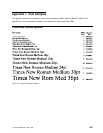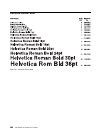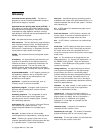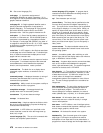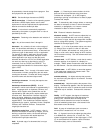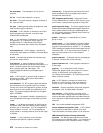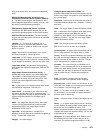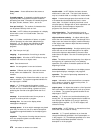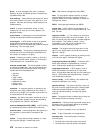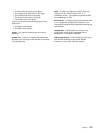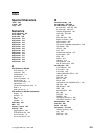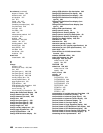utility, print format utility, and resource management
utility.
IBM AS/400 Manufacturing, Accounting,and
Production Information Control System I (MAPICS
I). The IBM licensed program that provides a set of
twelve integrated applications including financial, order
processing, and manufacturing packages.
IBM Operating System/400 Version 2 (OS/400).
Pertaining to the IBM licensed program that can be
used as the operating system for the AS/400 system.
IBM Client Access for AS/400. The IBM licensed
program that provides system functions to an attached
personal computer.
identifier. (1) The name of something. (2) A
sequence of bits or characters that identifies a user,
program, device, or system to another user, program,
device, or system.
image. An electronic representation of an original
document recorded by a scanning device.
image area. In AFP Utilities, an area on the display
where the image of an AFP resource is displayed when
a user designs the resource. See also
key entry area
.
image data stream. An advanced function printing
data stream that represents image data. See also
IO1
and
IM1
.
Image Object Content Architecture (IOCA). A
defined data stream used to store raster image data.
The images in a Mixed Object:Document Content
Architecture document are stored using IOCA. See
also
IO1
and
Mixed Object:Document Content
Architecture
.
IM1. A data tower of an intelligent printer data stream
that represents image data. See also
IO1
.
index search. A searchable part of the online help
information that provides “how-to” and explanatory
topics to supplement the help for specific displays. The
system-recognized identifier for the object type is
*SCHIDX.
IMDS. The Image Data Stream (IOCA). Advanced
Function Printing Utilities/400 can create the page
segment from IMDS. See image Object Content
Architecture (IOCA) and IO1.
input field. A field specified in a display file or
database file that is reserved for information supplied by
a user. Contrast with
output field
.
integrity. See
data integrity
.
intelligent printer data stream (IPDS). An
all-points-addressable data stream that allows users to
position text, images, and graphics at any defined point
on a printed page.
interactive. Pertaining to the dialog-like exchange of
information between people and a computer. Contrast
with
batch
.
IOCA. See
Image Object Content Architecture (IOCA)
.
IO1. A data tower of an intelligent printer data stream
that represents image data. Both IM1 and IO1
represent a raster pattern, but IO1 commands provide
additional functions. See also
IM1
and
Image Object
Content Architecture (IOCA)
.
IPDS. See
intelligent printer data stream (IPDS)
.
job. A unit of work to be done by a computer.
job description. A system object that defines how a
job is to be processed. The object name is *JOBD.
job log. A record of requests submitted to the system
by a job, the messages related to the requests, and the
actions performed by the system on the job. The job
log is maintained by the system program.
job name. The name of the job as identified to the
system. For an interactive job, the job is assigned the
name of the work station at which the job was started;
for a batch job, the name is specified in the command
used to submit the job. Contrast with
qualified job
name
.
Kanji. Characters originating from the Chinese
characters used in the Japanese written language.
key entry area. In AFP Utilities, an area shown at the
lower part of the image area for entering the parameters
for an element. See also
image area
.
label. (1) The name of a file on a diskette or tape.
(2) An identifier of a command or program statement
generally used for branching.
leader. The blank section of tape at the beginning of a
reel.
library. (1) A system object that serves as a directory
to other objects. A library groups related objects, and
allows the user to find objects by name. The
system-recognized identifier for the object type is *LIB.
Compare with
folder
and
document library
. (2) The set
of publications for a system.
library list. A list that indicates which libraries are to
be searched and the order in which they are to be
searched. The system-recognized identifier is *LIBL.
Glossary 473



